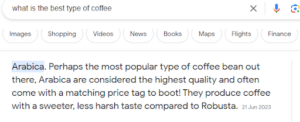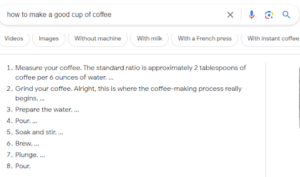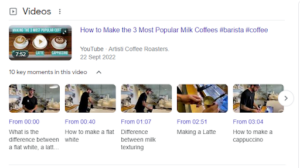- Backlinks Explained: Why Your Backlinks Aren’t Paying Off - April 10, 2024
- Boost Your Agency’s Credibility: A Guide to Online Reputation - April 10, 2024
- URL Slugs for SEO: A Comprehensive Guide - April 10, 2024
In the digital world, knowing how to boost your website’s performance is crucial. After all, the more traffic, engagement, and clicks you receive, the easier it will be to grow your business.
Fortunately, there are many ways in which you can achieve this goal, such as by using the right keywords or learning more about the world of SEO. This way, you can ensure that your website ranks highly across all search engines, from Google to Bing. However, one of the most effective ways to drive traffic toward your website on Google is by mastering the art of featured snippets.
What is a featured snippet?
A featured snippet is a small section of text featured above the ranked websites on a Google search result.
For this reason, it is often referred to as position “0”, as it appears before the top-ranking websites.
A featured snippet is automatically pulled from a web page by the search engine and often gives a direct answer/response to the searcher’s query.
Below is a featured snippets example that appears when you ask Google, “Why do people drink coffee in the morning?.”
The above image is an example of a paragraph snippet, though there are many other formats of featured snippets that you should add to your website, blogs, and online content.
Many benefits are associated with having your content appear as a featured snippet. For example, it can help to drive traffic towards your website, increasing the amount of clicks you receive. It also signifies to the reader that your content is authoritative and trustworthy, as it is being ranked and indexed by Google.
Understanding Different Types of Featured Snippets
As mentioned above, there are four main types of featured snippets:
- Paragraph Snippets,
- List Snippets,
- Table Snippets,
- Video Snippets.
Paragraph snippets
Paragraph snippets, as the name suggests, refer to sections of text (paragraphs), typically between 40 and 50 words in length. Sometimes, the keywords or phrases will be highlighted in blue, making it easier for the user to find the exact information they seek.
List snippets
List snippets are bulleted/numbered lists that appear after a search has been inputted. They are often instructional in nature and talk the user through a step-by-step process. As such, they’re more likely to appear in searches where the user has asked a “how-to” question.
Table snippets
In table snippets, the information is presented in a table at the top of the search results. This is typically used for data-based queries. Typically, the tables will be split into no more than three columns, so that the information presented remains easy to digest and skim read.
Video snippets:
Video snippets are short sections of longer videos, which again serve to answer a specific question on behalf of the viewer. While clicking on the video will give the viewer the option to watch the full-length video, a specific time-stamped section will be featured first.
The User-Intent Behind Featured Snippets
If you’re looking to create content that could become a featured snippet for a specific search or query, it’s important that you first understand the user intent behind featured snippets. For those unfamiliar with the term, user intent “refers to the underlying motivation someone has when searching online.” For example, a user could be searching with the intent of buying something, or to find out important information.
Featured snippets are Google’s way of ensuring that their user’s needs are met when browsing online. For this reason, they are designed to help users or searchers find the information they are looking for quickly and efficiently without having to scroll through multiple websites or even click on a link at all.
However, quick knowledge retrieval is not the only form of user intent you should cater to when creating this content; it really depends on the nature of the search itself. For example, if a user is asking, “Which is the best coffee brand,” they’re likely looking for list or table-based content, comparing or ranking different brands, as opposed to a singular answer.
The SEO Landscape: Then vs. Now
By now, you’re likely well aware of the role good SEO plays in the success of your online content. However, while in previous years, this largely revolved around keywords and keyword phrases, they are no longer the only factors that impact your ranking. In fact, search engines such as Google are constantly updating their criteria for high-ranking websites, taking into account website accessibility and functionality too (among other factors.)
For example, Google featured snippets were not properly introduced until 2014. However, they have quickly risen in popularity. In fact, a recent study found that featured snippets get 35.1% of all clicks – which means that they can play a crucial role in building your online presence.
Deep Dive: Anatomy of an Effective Featured Snippet
In order to ensure your content is selected as the “featured snippet,” for a specific search or query, you need to know how to properly curate this content.
To begin with, this means you need to do some research into which kind of featured snippet you need to create based on the query you are targeting. For example, are your audience looking for a step-by-step guide or a direct answer to a specific question?
Typically, you can determine what kind of content you should create based on the current featured snippet’s format. You then need to curate content that rivals this, so that you are able to take their spot.
This means that once you know which style of featured snippet you’d like to create, then you need to think about formatting, structure, and your choice of language/keywords.
Paragraph snippets:
Paragraph snippets should be 40-50 words in length, though they can be up to 60 words in some cases. As a general rule of thumb, however, it’s important that you are as succinct as possible. This is because users do not want to read a big body of text to find an answer to their question. Furthermore, longer bodies of text are unlikely to be selected as snippets to begin with, as it goes against the nature of what a snippet is.
When writing content that you’d like to be used as a featured snippet, you must ensure that you answer the question as directly as possible within the first sentence of the paragraph. This increases the chances of the algorithm picking out (and featuring) this content, as the search engine can see that your content serves a clear purpose and function. You should also ensure that you utilize the relevant keywords in this content without falling victim to keyword stuffing.
Conversational language should also be used throughout, as this will mimic the language used by the searcher. This also serves the purpose of making your content more engaging, as it “can lead to higher user engagement, longer time spent on your website, and increased interactions with your content.”
List snippets (bulleted and numbered)
When necessary, structuring your content into bullet points or lists can also ensure that your content becomes a featured snippet. When curating this content, use different heading tags to help search engines differentiate between the instruction itself and any further information you add. This makes it easier for them to feature the right content within the snippet.
Again, you should also ensure that you use the relevant keywords/keyword phrases and conversational language when curating this kind of content.
Table snippets
Featuring tables and other similar diagrams on your web pages can make it easier for this kind of content to be featured, thus driving traffic towards your website. Again, it’s important that you find a succinct way to display this information, especially if it involves complex data or statistics that users would otherwise find confusing or overwhelming.
Remember, your goal is to make it easier for users to find what you are looking for, so you should ensure that all information is as digestible and easy to read as possible. For this reason, table snippets tend to be no more than three columns in size.
Video snippets:
When it comes to ensuring your videos are used as content features, you need to ensure that your videos are properly titled and that you’ve added a relevant, tailored description that features the right keywords. This makes it easier for search engines like Google to categorize your videos properly.
So that the right segment of your video is selected, you should also add timestamps to the video description. Again, this makes it easier for the search engine to understand the content of the video and whether or not you are meeting the user’s needs. Captions can also prove useful in this regard while also making your content more accessible as a whole.
Optimization Strategies: Content & Code
Fortunately, there are many different ways you can optimize your Google featured snippets in addition to more form-specific methodologies outlined above. For example, you should:
- Use a range of header tags (H1, H2, H3). This indicates to the search engine that your content is properly structured and easy to follow. It also makes it easier for them to extract relevant content from your web page.
- Use meta tags and descriptions to your advantage, providing further insight into the content you are creating. Again, this often plays a key role in your website’s overall ranking.
- Ensure that the relevant keywords and keyword phrases are featured throughout your content, primarily within the sections you’d like to be used as featured snippets. You can use an SEO Auditing tool to ensure your content is up to scratch across your website.
- Ensure that your website functions as intended, without delays and broken links. This could otherwise cause the search engines to disregard your website.
You could also use a Google snippet tool to create this kind of content, saving yourself a considerable amount of time and energy.
Voice Search and Its Connection to Featured Snippets
The number of people using voice search is growing year-on-year. For example, a recent study found that “125.2 million people around the globe used voice search functions in 2023, as opposed to 123.5 million in 2022.” This is likely due to the fact that voice search functions and AI assistant technology are now embedded into our phones. It’s also much easier to ask a question out loud than it is to search for something manually.
Typically, the answer given through voice search is taken directly from the featured snippet from that search – which is why taking “position 0” on Google is crucial. After all, when you ask Alexa/Siri a question, they do not list content from multiple websites.
You must use conversational language when trying to ensure your featured snippet is selected for voice searches, such as on an Amazon Alexa device. This mimics the user’s natural speech and ensures that they get a succinct answer to their question.
Tracking and Measuring Success
Tracking and measuring your success is always important, whether you’re studying web traffic or determining whether or not your SEO efforts are paying off.
Regarding featured snippets, the easiest way to track your success is by carrying out some searches to see if your site is the source of the featured snippet for various relevant searches/questions. If not, this could be a sign that you must rework your content to steal the top spot from a competitor.
Once you’ve claimed this position, you can begin to track the effectiveness of your snippet based on the web traffic you receive as a result (i.e., the number of people clicking on your site or reading more of your content on the back of this snippet). If you aren’t getting a great click-through rate, this could mean that you need to improve the overall quality of your content, ensuring it is as engaging as possible and that you match the user intent.
The Future of Featured Snippets
Moving forward, featured snippets will continue to play a key role in generating web traffic and can also be used to help establish your brand as an authoritative, reputable source. After all, Google’s choice to display this information first lends credibility to your company, which could help you distinguish yourself from your competitors or top-ranking websites.
Right now, just 19% of SERPs (Search Engine Results Pages) have featured snippets. However, this number is likely to grow quite considerably in recent years. As such, this area of SEO best practices must not be ignored. Whenever creating new content for your blog, try to think about ways to create content that could be pulled out and used as a featured snippet. For example, you could finish off a blog with Q&A-style content.
Conclusion.
Featured snippets are short phrases, bodies of text, or even videos extracted from web content by search engines such as Google. They are often the first piece of information that appears after a user has asked a question online and are selected upon the assumption that they provide the user with the exact answer they are looking for. They appear at the very top of the results page, above the top-ranking websites.
Google began to use this feature in order to make it easier for web users to find the information they are looking for as quickly as possible, without having to scroll through multiple different web pages. For this reason, featured snippets tend to be:
- Concise and to the point, answering questions as directly as possible.
- Written in simple, conversational language that mimics the language used/inputted by the user.
- SEO-optimized, targeting specific keywords or phrases relevant to the overall search.
There are many benefits associated with being the featured snippet for a specific search or phrase. Firstly, it can bring a great deal of traffic to your website while also helping you to put your brand on the map. As they position you highly at the top of the search engine results page, it also means that people are more likely to consider you an authoritative source moving forward.
As such, whether you’re conducting an SEO audit or looking for ways to improve your website’s online performance in 2024, start by trying to claim the featured snippet for industry-relevant searches – you’ll soon notice the benefits of doing so!
When curating this content, remember to:
- Use conversational language alongside relevant keywords and phrases.
- Ensure that you understand the user intent behind the search that you are targeting so that you can curate the right style of the snippet, whether that be a paragraph or video.
- Constantly update the content to ensure that it continues to perform well moving forward. Check your website’s overall performance or performance metrics throughout to ensure that your efforts are paying off.
- Stay in tune with algorithm updates so that you can edit content accordingly.
- Use a Google snippets tool to generate the right content.





